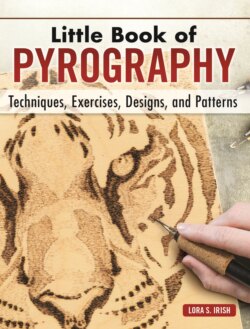Little Book of Pyrography

Реклама. ООО «ЛитРес», ИНН: 7719571260.
Оглавление
Lora S. Irish. Little Book of Pyrography
Acknowledgments
Table of Contents
What is pyrography?
Introduction
Pyrography Systems
One-Temperature Tools
Variable-Temperature Burners
Pyrography Tips
General Supplies
For sanding:
For cleaning tool tips:
For tracing:
And generally…
BASIC SUPPLY LIST:
Surfaces
Vegetable-Tanned Leather
Soft surface
Dried Gourds
Chipboard
Papier-Mâché
Artist Paper
Cotton Fabric and Canvas
Wood
Features to Consider
Hard Wood or Soft Wood?
Fine Grain or Coarse Grain?
Plain Grain or End Grain?
High Sap Contents or Low Sap Contents?
Light Wood or Dark Wood?
Untreated or Pretreated?
Wood Species
Basswood
Basswood, End Grain
Birch
Birch, Heartwood Grain
White Pine and Sugar Pine
White Pine, Sapwood
Butternut
Practice Board
Using Shading and Texture
Creating Light and Dark Tones
PRACTICE BOARD FOR TWO DIFFERENT TOOLS
Temperature of the Tip
Conducting Burn Tests
MY EXAMPLE SETTINGS FOR BIRCH PLYWOOD ARE:
Burning Time
Layers of Strokes
Type of Tip
ONE-TEMPERATURE TOOL TECHNIQUES
Style of Stroke
Creating texture strokes
Physical, or Actual, Texture
VARIABLE-TEMPERATURE TOOL TECHNIQUES
Creating a Wood Practice Board
Temperature settings
Three Common Fill Patterns
Quick Reference Texture Chart
Tonal Values Practice Board(Uses pattern on see here.)
SUPPLIES:
Exercises for Practice
Light and Dark Exercise One: Temperature of the Tip
Tips for completing the entire pattern:
Light and Dark Exercise Two: Burning Time
Tips for completing the entire pattern:
Light and Dark Exercise Three: Layers of Strokes
Tips for completing the entire pattern:
Light and Dark Exercise Four: Texture Pattern
Tips for completing the entire pattern:
Light and Dark Exercise Five: Putting It All Together
Texture Exercise: Putting Textures Together
Finding Tonal Values: Composition of a Good Woodburning
Understanding Tonal Values
What Exactly Are Tonal Values?
Finding the Tonal Values in a Photo or Drawing
Value #1—Black (darkest value)
Value #2—Dark chocolate (dark value)
Value #3—Milk chocolate (medium-dark value)
Value #4—Coffee with cream (medium value)
Value #5—Tanned leather (light-medium value)
Value #6—Caramel (light value)
Value #7—Linen (palest value)
Value #0—Unburned areas
Transferring the Values
Tonal Value Excercise: The Pocket Watch
Creating a Real Wall Clock
PROJECT
Step-by-Step: The Dragonette
Tonal values for Dragonette
Steps 1-6: Transferring the pattern
Steps 7-10: Shading one side of the body
Steps 11-12: Shading the remaining body
Steps 13-15: Belly-fold shading
Steps 16-18: Belly shading for the remaining side
Steps 19-20: Adding wing shadows to the body
Steps 21-33: Detailing the face
Steps 34-35: Long wing feathers
Step 36: Adding a second layer to the back
Step 37: Outlining the shoulder feathers
Steps 38-41: Burning the shoulder feathers and tail
Steps 42-43: Shading the body of the shield
Steps 44-46: Adding extra layering to the shield
Steps 47-52: Finishing
The finished Dragonette
Dragonette Chessboard
Dragonette Chessboard with Coloring
Dragonette Chessboard Color Chart
Gallery
About the Author
Отрывок из книги
I wish to extend my deepest thanks to Chris Reggio, Tiffany Hill, Kaitlyn Ocasio, Justin Speers, and David Fisk for their excellent work in creation, development, and refinement of this manuscript. As an author it is a wonderful experience to be working with such a well-skilled team.
Pyrography Systems
.....
When working on cotton canvas, you will want several sheets of heavy cardboard and long quilter’s straight pins to secure the cloth so that you are working on a tight, nonmoving surface. Canvas stretchers can be purchased at your local art store so that you can secure large pieces of canvas fabric.
Also include white artist erasers in your kit. Please avoid pink erasers, as they can leave pink streaks of color on your work surface that are not easily removed. The white eraser cleans up any leftover tracing lines and any oil or dirt from your hands that builds up during a burning session.
.....